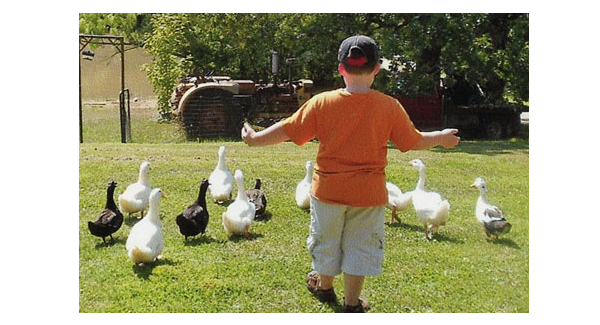Maybe you already keep chickens or other poultry and are considering adding ducks. Or maybe you’re thinking of starting with ducks as your first foray into the world of poultry. To help you decide whether or not duck keeping is for you, here are some of the benefits of keeping ducks.
Ducks are easy to house.
Ducks require little in terms of housing, since they prefer to be outdoors. All they need is a simple shelter where they can get in from bad weather and where they can be enclosed at night as protection from predators. A fence will further deter predators, while keeping the ducks from wandering afar.
Ducks are super healthy.
Ducks remain healthy when furnished with adequate facilities for safety, comfort, and sanitation, provided clean water for drinking and bathing, and fed a balanced diet. Duck diseases are rare. Any health issues are more likely to involve an injury or other noncontagious condition.
Ducks are easy to control.
Ducks generally follow the leader. Since they move as a group, they are easy to herd. They are also creatures of habit. Once they learn the daily routine, such as going inside their shelter at night, they don’t need reminders.
Ducklings grow fast.
Ducklings require less time under brooder heat than most other backyard poultry. When daytime temperatures remain above 65°F and nights are not overly chilly, ducklings may live permanently in their outdoor shelter and fenced run at about 4 weeks of age.
Ducks thrive in all climates.
Ducks are both heat tolerant and cold hardy. They are less apt than chickens to suffer in warm weather and are less sensitive to cold weather. And they don’t mind wet weather. In fact, they love it.
Ducks are excellent at pest control.
They love foraging in the garden for slugs, snails, grasshoppers, potato beetles, and more. In a pond they are good at controlling mosquito larvae, as well as duckweed and other unwanted vegetation. Given sufficient forage, ducks can satisfy up to 90% of their own nutritional needs.
Ducks produce fertilizer.
For gardeners, one of the benefits of keeping ducks is their copious production of high-nitrogen fertilizer. Waste gleaned from a duck shelter makes excellent compost. Water from a duck pool may be drained into the garden as liquid fertilizer. The water dilutes the droppings enough to avoid causing nitrogen burn to growing plants.
Duck eggs are delicious.
A quick online search reveals a multitude of culinary and nutritional benefits of duck eggs, which can cost a pretty penny at the local farmers’ market. Luckily, one of the benefits of keeping ducks is the ready availability of fresh duck eggs.
Duck meat is excellent.
Duck meat is both flavorful and inexpensive to produce. Because ducks are fast growers and good foragers, they can be ready for the table at much less cost than most other poultry. Although ducks have a lot of internal fat, the meat itself is pretty lean.
Ducks are gentle.
They hardly ever fight with one another, and rarely if ever attack humans. Of course, family or visiting dogs, children, and all others should be taught to move quietly among the ducks and never chase or tease them. Treated with respect, ducks readily become attached to their human handlers.
Ducks are attractive.
They come in a variety of colors from all white, brown, or black to a patchwork of mixed colors including iridescent green and brilliant blue. Swimming in a pond or just wandering around the lawn, ducks add an elegant touch to any backyard.
Ducks are fun!
Watching their antics provides endless hours of entertainment. The seemingly peculiar behavior of ducks often makes us humans laugh out loud. Lots of folks keep ducks simply for the pure joy of it.
















Forging her own future in the poultry industry
Farming is known to be a difficult industry, but emerging farmers typically face greater challenges than their established counterparts, with red tape and moribund processes presenting a significant obstacle to market access. That’s why Yolanda Klow, owner of Queens Nest Farms, says that emerging farmers must create their own opportunities.
Yolanda has been following her own advice since she registered her 22 hectare farm located in Tarlton, in 2020. At the time, she had been managing a butchery, however, when the Covid pandemic forced its closure, she realised she had to look to other avenues for income.
The answer came in the form of eggs. “There was always enormous demand for eggs from our customers at the butchery – not surprising, when you consider that they are a convenient, inexpensive form of protein,” Yolanda says. While at the butchery, she had satisfied this demand by purchasing eggs from small farms, but once the shop had closed, she decided to use her own resources.
As luck would have it, Yolanda already had a starting point: in 2018, she had purchased a farm, “because farming is in my blood”. “My grandmother was a farmer, working with chickens, pigs and dairy cows, and as children, my siblings and I would spend every holiday with her. It was my happy place; I love the peace of a farm.”
A farm might be peaceful, but trying to break into the industry brings an enormous amount of stress, as Yolanda was to discover. “When we started out, there was no water supply on the farm. We had to source water from our neighbours. We tried to overcome this by drilling for a borehole, but our first attempt came up dry. Luckily, we were more successful the second time around, but by this time, we were financially stricken.”
Loadshedding was another problem, and Yolanda’s family agreed to install the solar panels from their own home at the farm to ensure it kept running.
These difficulties were initially offset by the success of the egg business. Queens Nest Farm started out supplying eggs from Yolanda’s brood of 2 400 hens to customers in both the formal and informal markets, and demand was encouraging. “Although it was a tough time for South Africans from an economic perspective, people will always need to eat,” Yolanda says.
Even so, the rising cost of chicken feed placed pressure on the business, and so she decided to diversify by introducing crops to the farm. This turned out to be no simple exercise, as Yolanda wanted to convert to organic farming. “I was concerned by reports of the rising incidence of cancer and other diseases, especially among young people. The chemicals in our food clearly play a role here, and I wanted to provide a solution. Plus, organic farming is better for the land. There are so many farms that are no longer productive because the soil has been damaged by the prolonged use of chemicals.” After a long period of trial and error, and a steep learning curve, Queens Nest is currently undergoing organic certification.
Yolanda is extremely proud that the farm will be supplying retailers like Boxers and Pick n Pay – and proud, too, that she is helping to educate the industry about the importance of embracing organic farming. She explains that her team has been given the distribution rights for Bio Humix, an organic liquid fertiliser, and she is eager to educate her industry peers about the benefits of this product. “We’ve noticed a great improvement in our own produce; it’s phenomenally sweet and truly delicious. But more than this, we’re contributing to the sustainability of our land.”
It hasn’t been easy to reach this point, Yolanda admits. Apart from following an arduous process to have Bio Unique registered by the Department of Agriculture and fighting through bureaucracy to see her products placed on shelves, as a female farmer, other stakeholders often regard her with scepticism. “But I am resilient person. No matter what challenges I face, I am ready to do whatever it takes to make this business grow,” she promises.
Source: Farmers Review Africa